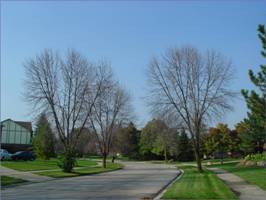Emerald Ash Borer: A Proactive Approach
 Emerald Ash Borer: A Proactive Approach
Emerald Ash Borer: A Proactive Approach
Written by Matthew Logan, Owner/Operator Logan Tree Experts, ISA Certified Arborist, Tree Climber and Tree Risk Assessor.
Discovered in the Detroit-Windsor area in 2002, The Emerald Ash Borer, or EAB, is a non-native insect that attacks Ash trees of all ages, sizes and degrees of health.
EAB beetles are 2 cm long, metallic green colored insects. The adults feed on the leaves of Ash trees, however, it is the larvae that do the real damage. The grub-like larvae bore under the bark and feed on the tree tissues, eventually cutting off and destroying the tree’s ability to transport water and nutrients through its system for survival.
Although Ash trees infested with EAB may not show signs initially, look for thinned crowns, shoots growing from the roots and trunk, splits in the bark creating vertical cracks and “S” -shaped feeding galleries under the bark. You may also see signs that the adult beetles have emerged by the presence of “D”shaped exit holes. The exit hole is about the size of a “Q tip” and is not easily seen. Sometimes evidence of woodpeckers and squirrels can be seen where they have pulled off the bark, feeding on the larvae.
Containing EAB has been difficult as its spread has been quickened by the movement, often illegal, of ash firewood across the Province. EAB has already devastated Ash populations in southern Ontario. After failed attempts at isolating the beetle through mass removal of its food source, EAB has unfortunately been confirmed in communities that surround Peterborough, and as close as Oshawa. There are also infestations east of Kingston, in Ottawa, most of southwestern Ontario and an isolated population in Sault Ste Marie.
Can anything be done to save the Ash trees of the Kawarthas? Yes.
Even though EAB has been confirmed in the Kawartha region there is an opportunity to be proactive and start protecting Ash trees before they are infected. One option for protection is the application of TreeAzin, an approved insecticide. TreeAzin is a natural product made from Neem tree seeds. The Neem tree grows in India and many common household products such as bath soap are made from the seed extracts. As documented by the Canadian Forest Service, TreeAzin does not pose a significant risk to bees or other non-target species.TreeAzin is injected into the tree every two years and may only be applied by a licensed pesticide applicator and one who has been trained by the supplier of TreeAzin.
Contact Logan Tree Experts for a free assessment of your ash trees and a TreeAzin treatment quote. Call 705.657.6916 or email [email protected].

